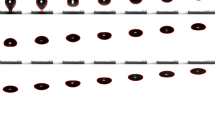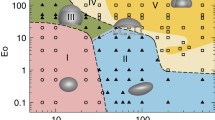Abstract
If a long air bubble is placed inside a vertical tube closed at the top it can rise by displacing the fluid above it. However, Bretherton found that if the tube radius, R, is smaller than a critical value \(R_{c}=0.918 \; \ell _c\), where \(\ell _c=\sqrt{\gamma /\rho g}\) is the capillary length, there is no solution corresponding to steady rise. Experimentally, the bubble rise appears to have stopped altogether. Here we explain this observation by studying the unsteady bubble motion for \(R<R_{c}\). We find that the minimum spacing between the bubble and the tube goes to zero in limit of large t like \(t^{-4/5}\), leading to a rapid slow-down of the bubble’s mean speed \(U \propto t^{-2}\). As a result, the total bubble rise in infinite time remains very small, giving the appearance of arrested motion.















Similar content being viewed by others
References
Bretherton, F.P.: The motion of long bubbles in tubes. J. Fluid Mech. 10, 166 (1961)
Dupont, T.F., Goldstein, R.E., Kadanoff, L.P., Zhou, S.-M.: Finite-time singularity formation in Hele-Shaw systems. Phys. Rev. E 47, 4182 (1993)
Constantin, P., Dupont, T.F., Goldstein, R.E., Kadanoff, L.P., Shelley, M.J., Zhou, S.-M.: Droplet breakup in a model of the Hele-Shaw cell. Phys. Rev. E 47, 4169 (1993)
Bertozzi, A.L., Brenner, M.P., Dupont, T.F., Kadanoff, L.P.: Singularities and similarities in interface flows. In: Sirovich, L. (ed.) Applied Mathematics Series, vol. 100, p. 155. Springer, New York (1994)
Boatto, S., Kadanoff, L.P., Olla, P.: Traveling-wave solutions to thin-film equations. Phys. Rev. E 48, 4423 (1993)
Kadanoff, L.P.: Singularities and blowups. Phys. Today 50(9), 11–12 (1997)
Jones, A.F., Wilson, S.D.R.: The film drainage problem in droplet coalescence. J. Fluid Mech. 87, 263 (1978)
Eggers, J., Fontelos, M.A.: Singularities: Formation, Structure, and Propagation. Cambridge University Press, Cambridge (2015)
Hinch, E.J.: Perturbation Methods. Cambridge University Press, Cambridge (1991)
Wilson, S.D.R., Jones, A.F.: The entry of a falling film into a pool and the air-entrainment problem. J. Fluid Mech. 128, 219 (1983)
Oron, A., Davis, S.H., Bankoff, S.G.: Long-scale evolution of thin liquid films. Rev. Mod. Phys. 69, 931–980 (1997)
Wilson, S.D.R.: The drag-out problem in film coating theory. J. Engg. Math. 16, 209 (1982)
Eggers, J., Stone, H.A.: Characteristic lengths at moving contact lines for a perfectly wetting fluid: the influence of speed on the dynamic contact angle. J. Fluid Mech. 505, 309–321 (2004)
Eggers, J., Dupont, T.F.: Drop formation in a one-dimensional approximation of the Navier-Stokes equation. J. Fluid Mech. 262, 205 (1994)
Duchemin, L., Lister, J.R., Lange, U.: Static shapes of levitated viscous drops. J. Fluid Mech. 533, 161–170 (2005)
Bender, C.M., Orszag, S.A.: Advanced Mathematical Methods for Scientists and Engineers. Mc Graw-Hill, New York (1978)
Yiantsios, S.G., Davis, R.H.: Close approach and deformation of two viscous drops due to gravity and van der waals forces. J. Colloid Interf. Sci. 144, 412–433 (1991)
Almgren, R., Bertozzi, A.L., Brenner, M.P.: Stable and unstable singularities in the unforced Hele-Shaw cell. Phys. Fluids 8, 1356 (1996)
Bonn, D., Eggers, J., Indekeu, J., Meunier, J., Rolley, E.: Wetting and spreading. Rev. Mod. Phys. 81, 739 (2009)
Hammoud, N., Trinh, P.H., Howell, P.D., Stone, H.A.: The influence of van der Waals interactions on a bubble moving in a tube (2016). arXiv:1601.00726
Eggers, J., Stone, H.A.: unpublished manuscript (2015)
Acknowledgments
We are grateful to Howard Stone for pointing out to us the paradox of the stuck bubble, and for enlightening discussions. Discussions with John Kolinski and Hyoungsoo Kim on the possibility of experiments are also gratefully acknowledged.
Author information
Authors and Affiliations
Corresponding author
Appendices
Appendix:1 Asymptotics for F as \(\eta \rightarrow 0\)
We would like to find the most general solution of (42) consistent with the linear asymptotics (43). To find the structure of the solution in this limit, we put \(F = B\eta + \delta \), where \(\delta \) is a small correction. Then the leading-order contribution to (42), coming from the first two terms on the left, is linear in \(\eta \), while \((F^3)_\eta \) is subdominant as \(\eta \rightarrow 0\). Linearizing the remaining term \((F^3F_{\eta \eta \eta })_{\eta }\) in \(\delta \), (42) yields:
Here and in the remainder of this appendix, primes denote the derivative with respect to the argument. Integrating (73) we find the general solution
where \(\delta _1,\dots ,\delta _4\) are constants of integration. The coefficients \(\delta _1\) and \(\delta _2\) must vanish, since they would dominate (43), contradicting our assumption, while \(\delta _3\) can be included in the constant B. Thus the leading behavior of F as \(\eta \rightarrow 0\) is
with a single free constant P.
The general form of the expansion must contain higher powers of \(\ln \eta \) as well, since powers of \(\ln \eta \) are generated by the term \(F^3\). A closer inspection shows that the most general expansion which balances the number of free coefficients with the number of equations is
where \(a_{10} = B\), \(a_{11} = 0\), \(a_{20}=P-9/(20B^2)\) and \(a_{21}=3/(10B^2)\) as shown above. The coefficients \(a_{ji}\) are now found recursively as follows. Substituting (75) into (42), at each order \(j\ge 3\) we obtain terms of the form
whose coefficients must equal zero, and which constitute a linear system of equations for \(a_{j+1,0},\dots ,a_{j+1,j-1}\). Starting with \(i=j-1\), this system can be solved recursively for \(a_{j+1,j-1}\), proceeding down to \(i=0\), which is an equation for \(a_{j+1,0}\). Implementing this scheme in MAPLE, we find
Appendix: 2 Asymptotics for F as \(\eta \rightarrow -\infty \)
Here we seek a description of solutions of (42) consistent with the asymptotics (47) as \(\eta \rightarrow -\infty \), so we put
into (42) and linearize in \(\delta \). Contributions coming from surface tension are subdominant at this order, and we obtain to leading order
where the right-hand side comes from gravity. This has the general solution
where Q is a constant of integration.
This suggests a general solution of the form
where all coefficients \(c_i\) can be determined uniquely, and contributions from surface tension come in at higher orders. The first few are,
determined by a single free constant Q.
Next we wish to find all solutions F to (11), which asymptote to \(\bar{F}\) as \(\eta \rightarrow -\infty \), by performing a linear stability analysis around \(\bar{F}\), using the ansatz:
We are interested in all possible \(\delta (\eta )\), which grow exponentially as \(\eta \rightarrow - \infty \). Inserting (81) into (42) and linearizing, we find
Since the coefficients depend on \(\eta \), we use the WKB ansatz \(\delta (\eta ) = e^{\lambda (-\eta )^{n}}\). For \(n>0\), the leading order balance as \(\eta \rightarrow -\infty \) is
which requires \(n = 5/6\) for the powers to balance, and we obtain the 4th order eigenvalue equation:
We are interested in roots with positive real part only, since negative roots decay exponentially as we integrate toward \(-\infty \) and \(\lambda = 0\) corresponds to the solution itself. There are two such eigenvectors with positive roots that solve (84):
leading to unstable solutions of the form
where \( \mathcal {A} = \frac{3}{25} 450^{1/3}\).
Rights and permissions
About this article
Cite this article
Lamstaes, C., Eggers, J. Arrested Bubble Rise in a Narrow Tube. J Stat Phys 167, 656–682 (2017). https://doi.org/10.1007/s10955-016-1559-z
Received:
Accepted:
Published:
Issue Date:
DOI: https://doi.org/10.1007/s10955-016-1559-z




